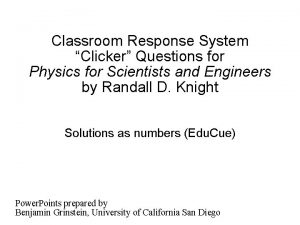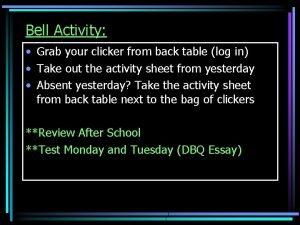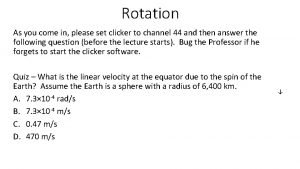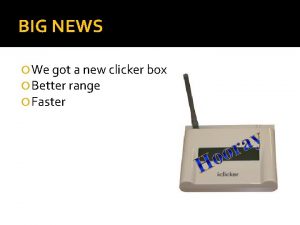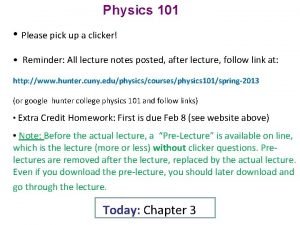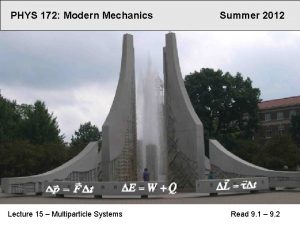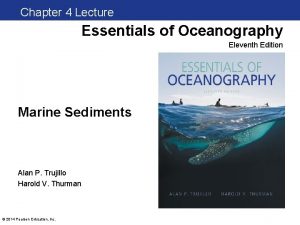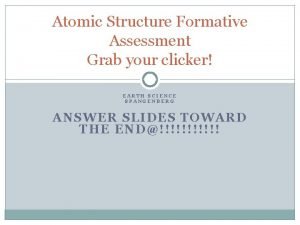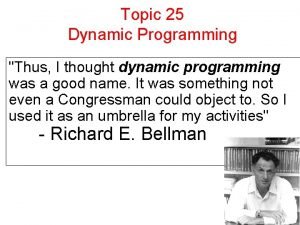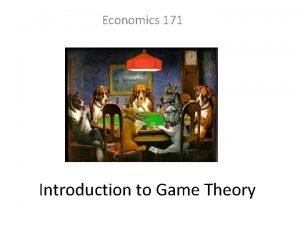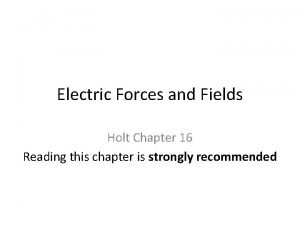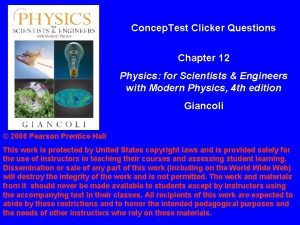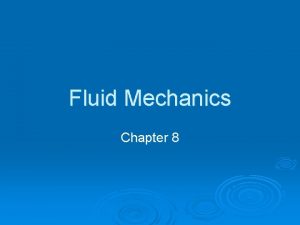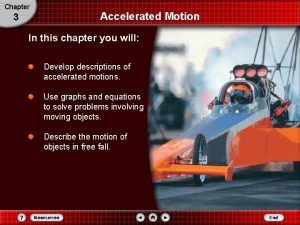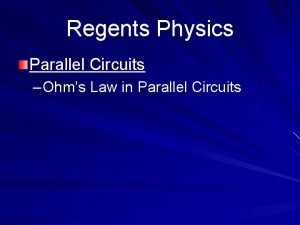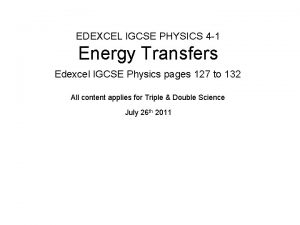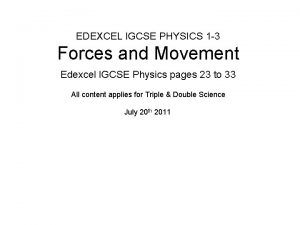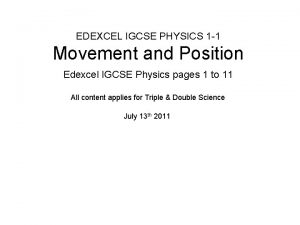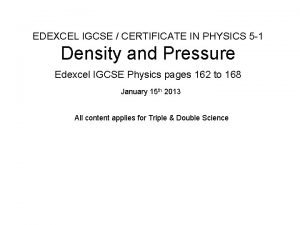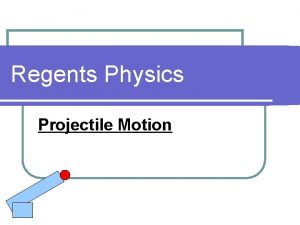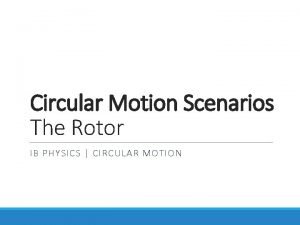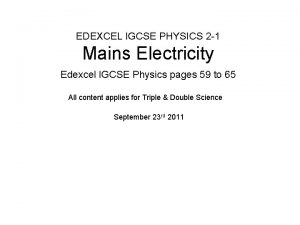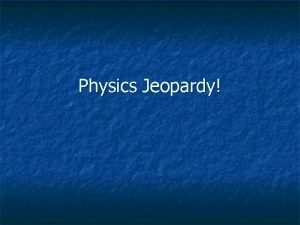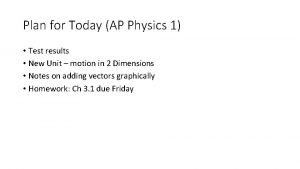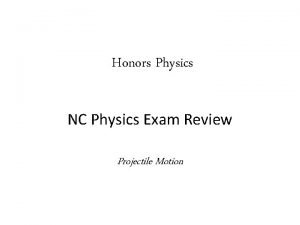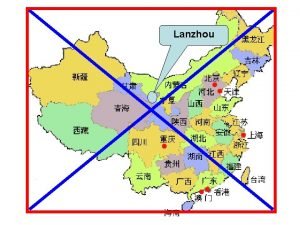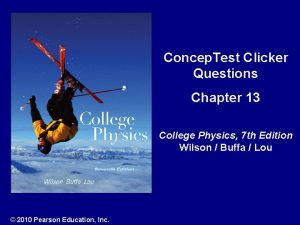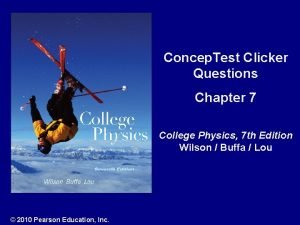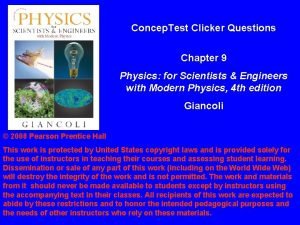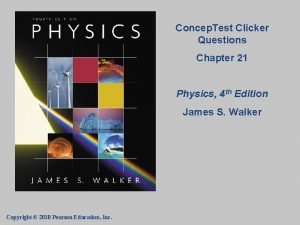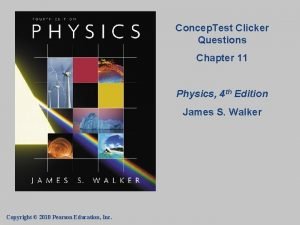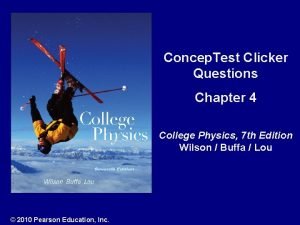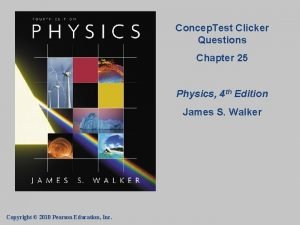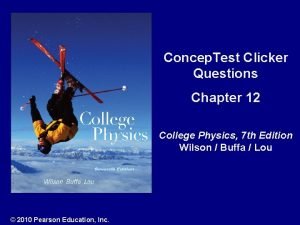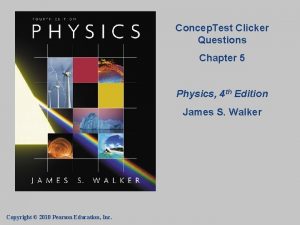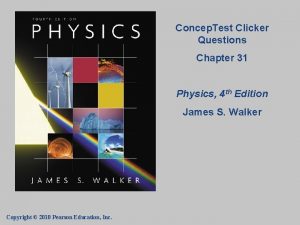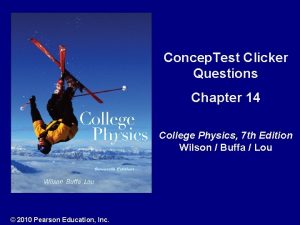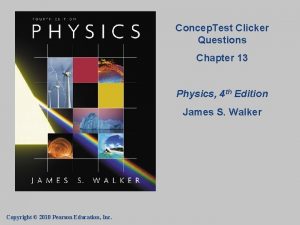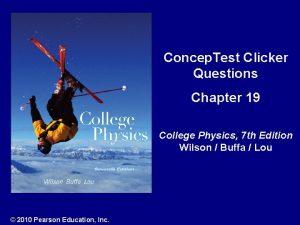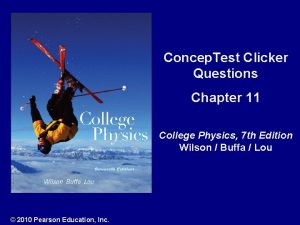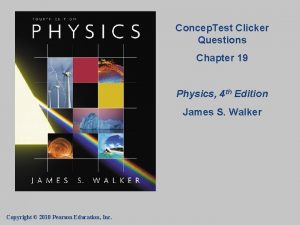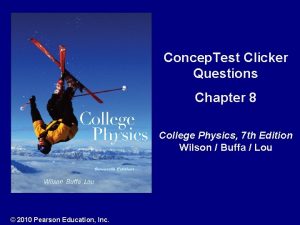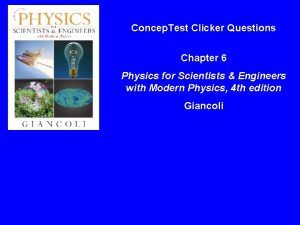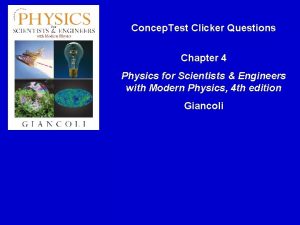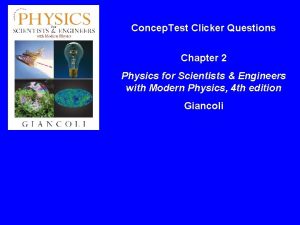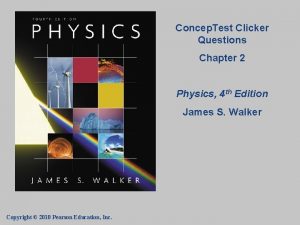Concep Test Clicker Questions Chapter 19 Physics 4

















































- Slides: 49

Concep. Test Clicker Questions Chapter 19 Physics, 4 th Edition James S. Walker Copyright © 2010 Pearson Education, Inc.

Question 19. 1 a Two charged balls are repelling each other as they hang from the ceiling. What can you say about their charges? Electric Charge I a) one is positive, the other is negative b) both are positive c) both are negative d) both are positive or both are negative

Question 19. 1 a Two charged balls are repelling each other as they hang from the ceiling. What can you say about their charges? Electric Charge I a) one is positive, the other is negative b) both are positive c) both are negative d) both are positive or both are negative The fact that the balls repel each other can tell you only that they have the same charge, charge but you do not know the sign. So they can be either both positive or both negative. Follow-up: What does the picture look like if the two balls are oppositely charged? What about if both balls are neutral?

Question 19. 1 b From the picture, what can you conclude about the charges? Electric Charge II a) have opposite charges b) have the same charge c) all have the same charge d) one ball must be neutral (no charge)

Question 19. 1 b From the picture, what can you conclude about the charges? Electric Charge II a) have opposite charges b) have the same charge c) all have the same charge d) one ball must be neutral (no charge) The GREEN and PINK balls must have the same charge, since they repel each other. The YELLOW ball also repels the GREEN, so it must also have the same charge as the GREEN (and the PINK).

Question 19. 2 a A metal ball hangs from the ceiling Conductors I a) positive by an insulating thread. The ball is b) negative attracted to a positive-charged rod c) neutral held near the ball. The charge of d) positive or neutral the ball must be: e) negative or neutral

Question 19. 2 a A metal ball hangs from the ceiling Conductors I a) positive by an insulating thread. The ball is b) negative attracted to a positive-charged rod c) neutral held near the ball. The charge of d) positive or neutral the ball must be: e) negative or neutral Clearly, the ball will be attracted if its charge is negative However, even if the ball is neutral, neutral the charges in the ball can be separated by induction (polarization), leading to a net attraction. Remember the ball is a conductor! Follow-up: What happens if the metal ball is replaced by a plastic ball?

Question 19. 2 b Conductors II Two neutral conductors are connected a) 0 0 by a wire and a charged rod is brought b) + – c) – + is removed. What are the charges on d) + + the conductors? e) – – near, but does not touch. The wire is taken away, and then the charged rod 0 0 ? ?

Question 19. 2 b Conductors II Two neutral conductors are connected a) 0 0 by a wire and a charged rod is brought b) + – c) – + is removed. What are the charges on d) + + the conductors? e) – – near, but does not touch. The wire is taken away, and then the charged rod While the conductors are connected, positive 0 0 ? ? charge will flow from the blue to the green ball due to polarization Once disconnected, the charges will remain on the separate conductors even when the rod is removed. Follow-up: What will happen when the conductors are reconnected with a wire?

Question 19. 3 a What is the magnitude Coulomb’s Law I a) 1. 0 N b) 1. 5 N of the force F 2? c) 2. 0 N F 1 = 3 N Q Q F 2 = ? d) 3. 0 N e) 6. 0 N

Question 19. 3 a What is the magnitude Coulomb’s Law I a) 1. 0 N b) 1. 5 N of the force F 2? c) 2. 0 N F 1 = 3 N Q Q F 2 = ? d) 3. 0 N e) 6. 0 N The force F 2 must have the same magnitude as F 1. This is due to the fact that the form of Coulomb’s law is totally symmetric with respect to the two charges involved. The force of one on the other of a pair is the same as the reverse Note that this sounds suspiciously like Newton’s 3 rd law!!

Question 19. 3 b F 1 = 3 N Q Q Coulomb’s Law II F 2 = ? b) 3. 0 N If we increase one charge to 4 Q, what is the magnitude of F 1? F 1 = ? 4 Q Q a) 3/4 N F 2 = ? c) 12 N d) 16 N e) 48 N

Question 19. 3 b F 1 = 3 N Q Q Coulomb’s Law II F 2 = ? b) 3. 0 N If we increase one charge to 4 Q, what is the magnitude of F 1? F 1 = ? 4 Q Q a) 3/4 N F 2 = ? c) 12 N d) 16 N e) 48 N Originally we had: F 1 = k(Q)(Q)/r 2 = 3 N Now we have: F 1 = k(4 Q)(Q)/r 2 which is 4 times bigger than before. Follow-up: Now what is the magnitude of F 2?

Question 19. 3 c Coulomb’s Law III The force between two charges a) 9 F separated by a distance d is F. If b) 3 F the charges are pulled apart to a c) F distance 3 d, what is the force on d) 1/3 F each charge? e) 1/9 F F ? Q Q F d Q Q 3 d ?

Question 19. 3 c Coulomb’s Law III The force between two charges a) 9 F separated by a distance d is F. If b) 3 F the charges are pulled apart to a c) F distance 3 d, what is the force on d) 1/3 F each charge? e) 1/9 F F Originally we had: Fbefore = k(Q)(Q)/d 2 = F Now we have: Fafter = k(Q)(Q)/(3 d)2 = 1/9 F ? Q Q F d Q Q 3 d Follow-up: What is the force if the original distance is halved? ?

Question 19. 4 a Electric Force I Two balls with charges +Q and +4 Q are fixed at a separation distance of 3 R. Is it possible to place another charged ball Q 0 on the line between the two charges such that the net force on Q 0 will be zero? a) yes, but only if Q 0 is positive b) yes, but only if Q 0 is negative c) yes, independent of the sign (or value) of Q 0 d) no, the net force can never be zero +4 Q +Q 3 R

Question 19. 4 a Electric Force I Two balls with charges +Q and +4 Q are fixed at a separation distance of 3 R. Is it possible to place another charged ball Q 0 on the line between the two charges such that the net force on Q 0 will be zero? a) yes, but only if Q 0 is positive b) yes, but only if Q 0 is negative c) yes, independent of the sign (or value) of Q 0 d) no, the net force can never be zero A positive charge would be repelled by both charges, so a point where these two repulsive forces cancel +4 Q +Q can be found. A negative charge would be attracted by both, and the same argument holds. Follow-up: What happens if both charges are +Q? Where would the F = 0 point be in this case? 3 R

Question 19. 4 b Electric Force II Two balls with charges +Q and +4 Q are separated by 3 R. Where should you place another charged ball Q 0 on the line between the two charges such that the net force on Q 0 will be zero? +4 Q +Q a b c d 2 R R 3 R e

Question 19. 4 b Electric Force II Two balls with charges +Q and +4 Q are separated by 3 R. Where should you place another charged ball Q 0 on the line between the two charges such that the net force on Q 0 will be zero? +4 Q +Q a b c d e 2 R R 3 R The force on Q 0 due to +Q is: F = k(Q 0)(Q)/R 2 The force on Q 0 due to +4 Q is: F = k(Q 0)(4 Q)/(2 R)2 Since +4 Q is 4 times bigger than +Q, Q 0 needs to be farther from +4 Q. In fact, Q 0 must be twice as far from +4 Q, since the distance is squared in Coulomb’s law.

Question 19. 4 c Electric Force III Two balls with charges +Q and – 4 Q are fixed at a separation distance of 3 R. Is it possible to place another charged ball Q 0 anywhere on the line such that the net force on Q 0 will be zero? a) yes, but only if Q 0 is positive b) yes, but only if Q 0 is negative c) yes, independent of the sign (or value) of Q 0 d) no, the net force can never be zero – 4 Q +Q 3 R

Question 19. 4 c Electric Force III Two balls with charges +Q and – 4 Q are fixed at a separation distance of 3 R. Is it possible to place another charged ball Q 0 anywhere on the line such that the net force on Q 0 will be zero? a) yes, but only if Q 0 is positive b) yes, but only if Q 0 is negative c) yes, independent of the sign (or value) of Q 0 d) no, the net force can never be zero A charge (positive or negative) can be placed to the left of the +Q charge, – 4 Q +Q such that the repulsive force from the +Q charge cancels the attractive force 3 R from – 4 Q. Follow-up: What happens if one charge is +Q and the other is –Q?

Question 19. 5 a Proton and Electron I A proton and an electron are held apart a distance of 1 m and then released. As they approach each other, what happens to the force between them? p a) it gets bigger b) it gets smaller c) it stays the same e

Question 19. 5 a Proton and Electron I A proton and an electron are held apart a distance of 1 m and then released. As they approach each other, what happens to the force between them? a) it gets bigger b) it gets smaller c) it stays the same By Coulomb’s law, the force between the two charges is inversely proportional to the distance squared So, the closer they get to each other, the bigger the electric force between them gets! p e Follow-up: Which particle feels the larger force at any one moment?

Question 19. 5 b Proton and Electron II A proton and an electron are held a) proton apart a distance of 1 m and then b) electron released. Which particle has the c) both the same larger acceleration at any one moment? p e

Question 19. 5 b Proton and Electron II A proton and an electron are a) proton held apart a distance of 1 m b) electron and then released. Which particle has the larger c) both the same acceleration at any one moment? p The two particles feel the same force Since F = ma, the particle with the smaller mass will have the larger acceleration This is the electron. e

Question 19. 5 c A proton and an electron are held apart a distance of 1 m and then let go. Where would they meet? Proton and Electron III a) in the middle b) closer to the electron’s side c) closer to the proton’s side p e

Question 19. 5 c A proton and an electron are held apart a distance of 1 m and then let go. Where would they meet? Proton and Electron III a) in the middle b) closer to the electron’s side c) closer to the proton’s side By Newton’s 3 rd law, the electron and proton feel the same force But, since F = ma, and since the proton’s mass is much greater, greater the proton’s acceleration will be much smaller! smaller p e Thus, they will meet closer to the proton’s original position Follow-up: Which particle will be moving faster when they meet?

Question 19. 6 a Forces in 2 D b c Which of the arrows best d represents the direction of the net force on charge +2 Q d +Q +Q due to the other two charges? d +4 Q e

Question 19. 6 a Forces in 2 D b c Which of the arrows best d represents the direction of the net force on charge +2 Q d +Q +Q due to the other two d charges? +4 Q The charge +2 Q repels +Q toward the right. The charge +4 Q repels +Q upward, but with a stronger force. Therefore, the net force is up and to +2 Q the right, but mostly up. up Follow-up: What would happen if the yellow charge were +3 Q? +4 Q e

Question 19. 7 Electric Field You are sitting a certain distance from a point charge, and you measure an electric field of E 0. If the charge is doubled and your distance from the charge is also doubled, what is the electric field strength now? a) 4 E 0 b) 2 E 0 c) E 0 d) 1/2 E 0 e) 1/4 E 0

Question 19. 7 Electric Field You are sitting a certain distance from a point charge, and you measure an electric field of E 0. If the charge is doubled and your distance from the charge is also doubled, what is the electric field strength now? a) 4 E 0 b) 2 E 0 c) E 0 d) 1/2 E 0 e) 1/4 E 0 Remember that the electric field is: E = k. Q/r 2. Doubling the charge puts a factor of 2 in the numerator, but doubling the distance puts a factor of 4 in the denominator, because it is distance squared!! Overall, that gives us a factor of 1/2 Follow-up: If your distance is doubled, what must you do to the charge to maintain the same E field at your new position?

Question 19. 8 a Between the red and the blue charge, which of them experiences the greater electric field due to the green charge? +1 d +2 Field and Force I a) +1 b) +2 c) the same for both +1 d +1

Question 19. 8 a Between the red and the blue charge, which of them experiences the greater electric field due to the green charge? +1 d Field and Force I a) +1 b) +2 c) the same for both +2 Both charges feel the same electric field due to the green charge because they are at the same point in space! space +1 d +1

Question 19. 8 b Between the red and the blue charge, which of them experiences the greater electric force due to the green charge? +1 d +2 Field and Force II a) +1 b) +2 c) the same for both +1 d +1

Question 19. 8 b Between the red and the blue charge, which of them experiences the greater electric force due to the green charge? +1 d +2 Field and Force II a) +1 b) +2 c) the same for both +1 The electric field is the same for both charges, but the force on a given charge also depends on the magnitude of that specific charge d +1

Question 19. 9 a Superposition I -2 C What is the electric field at b a the center of the square? c e) E = 0 -2 C d

Question 19. 9 a Superposition I -2 C What is the electric field at b a the center of the square? c e) E = 0 -2 C For the upper charge, the E field vector at the center of the square points toward that charge. For the lower charge, the same thing is true. Then the vector sum of these two E field vectors points to the left Follow-up: What if the lower charge were +2 C? What if both charges were +2 C? d

Question 19. 9 b What is the electric field at Superposition II -2 C b -2 C a the center of the square? c e) E = 0 -2 C d -2 C

Question 19. 9 b What is the electric field at Superposition II -2 C b -2 C a the center of the square? c e) E = 0 -2 C The four E field vectors all point outward from the center of the square toward their respective charges. Because they are all equal, the net E field is zero at the center!! center Follow-up: What if the upper two charges were +2 C? What if the right-hand charges were +2 C? d -2 C

Question 19. 9 c Superposition III -Q +Q What is the direction of the electric field at the position of the X ? b c a d +Q e

Question 19. 9 c Superposition III -Q +Q What is the direction of the electric field at the position of the X ? b c a d +Q e The two +Q charges give a resultant E field that is down and to the right The –Q charge has an E field up and to the left, left but smaller in magnitude. Therefore, the total electric field is down and to the right Follow-up: What if all three charges reversed their signs?

Question 19. 10 Two charges are fixed along the x axis. They produce an electric field E directed along the negative y axis at the indicated point. Which of the following is true? Find the Charges a) charges are equal and positive b) charges are equal and negative c) charges are equal and opposite d) charges are equal, but sign is undetermined e) charges cannot be equal y E Q 1 Q 2 x

Question 19. 10 Two charges are fixed along the x axis. They produce an electric field E directed along the negative y axis at the indicated point. Which of the following is true? Find the Charges a) charges are equal and positive b) charges are equal and negative c) charges are equal and opposite d) charges are equal, but sign is undetermined e) charges cannot be equal y The way to get the resultant PINK vector is to use the GREEN and BLUE vectors. These E vectors correspond to equal E charges (because the lengths are equal) that are both negative (because their directions are toward the charges). Q 1 Q 2 Follow-up: How would you get the E field to point toward the right? x

Question 19. 11 Uniform Electric Field In a uniform electric field in empty space, a 4 C charge is placed and it feels an electric force of 12 N. If this charge is removed and a 6 C charge is placed at that point instead, what force will it feel? Q a) 12 N b) 8 N c) 24 N d) no force e) 18 N

Question 19. 11 Uniform Electric Field In a uniform electric field in empty space, a 4 C charge is placed and it feels an electric force of 12 N. If this charge is removed and a 6 C charge is placed at that point instead, what force will it feel? a) 12 N b) 8 N c) 24 N d) no force e) 18 N Since the 4 C charge feels a force, there must be an electric field present, with magnitude: E = F / q = 12 N / 4 C = 3 N/C Once the 4 C charge is replaced with a 6 C Q charge, this new charge will feel a force of: F = q E = (6 C)(3 N/C) = 18 N Follow-up: What if the charge is placed at a different position in the field?

Question 19. 12 a Electric Field Lines I a) What are the signs of the charges whose electric fields are shown at right? b) c) d) e) no way to tell

Question 19. 12 a Electric Field Lines I a) What are the signs of the charges whose electric fields are shown at right? b) c) d) e) no way to tell Electric field lines originate on positive charges and terminate on negative charges

Question 19. 12 b Which of the charges has the greater magnitude? Electric Field Lines II a) b) c) both the same

Question 19. 12 b Electric Field Lines II Which of the charges has the greater magnitude? a) b) c) both the same The field lines are denser around the red charge, charge so the red one has the greater magnitude Follow-up: What is the red/green ratio of magnitudes for the two charges?
 Clicker questions physics
Clicker questions physics Sa pamamagitan ng concept map gumawa ng reaksyong papel
Sa pamamagitan ng concept map gumawa ng reaksyong papel Mathclicker
Mathclicker E clicker
E clicker +audience +response +clicker
+audience +response +clicker Lesson 5 building an app clicker game
Lesson 5 building an app clicker game Earth clicker
Earth clicker Maximal heart rate
Maximal heart rate Hitler clicker
Hitler clicker Clicker stop motion
Clicker stop motion Cooi clicker
Cooi clicker Umbc clicker
Umbc clicker Clicker box
Clicker box Roger rabbit
Roger rabbit Clicker stop motion
Clicker stop motion Clicker
Clicker Phys 172
Phys 172 Hlyniany
Hlyniany Salt clicker
Salt clicker Clicker gravel transport
Clicker gravel transport Atomic clicker
Atomic clicker Touch the spacebar
Touch the spacebar Dynamic problem
Dynamic problem Question ball questions
Question ball questions Presentation clicker challenger
Presentation clicker challenger Sohcahtoa rule
Sohcahtoa rule Atomic clicker
Atomic clicker Clicker fungus
Clicker fungus Holt physics chapter 16 test
Holt physics chapter 16 test Chapter 12 physics test
Chapter 12 physics test Holt physics chapter 8 fluid mechanics test answers
Holt physics chapter 8 fluid mechanics test answers Chapter 2 assessment physics principles and problems
Chapter 2 assessment physics principles and problems Chapter 3 accelerated motion practice problems answers
Chapter 3 accelerated motion practice problems answers Why does it happen
Why does it happen University physics with modern physics fifteenth edition
University physics with modern physics fifteenth edition Ia physics ideas
Ia physics ideas Internal resistance
Internal resistance Energy flow diagram light bulb
Energy flow diagram light bulb Igcse physics forces and motion
Igcse physics forces and motion Movement and position physics
Movement and position physics Pressure formula
Pressure formula Regents physics projectile motion questions
Regents physics projectile motion questions Rotor circular motion
Rotor circular motion Ib physics chapter 5
Ib physics chapter 5 Mains electricity igcse physics
Mains electricity igcse physics Physics jeopardy questions
Physics jeopardy questions Ap physics vectors test
Ap physics vectors test Honors physics projectile motion test
Honors physics projectile motion test Mcas physics practice test
Mcas physics practice test Physics test
Physics test
